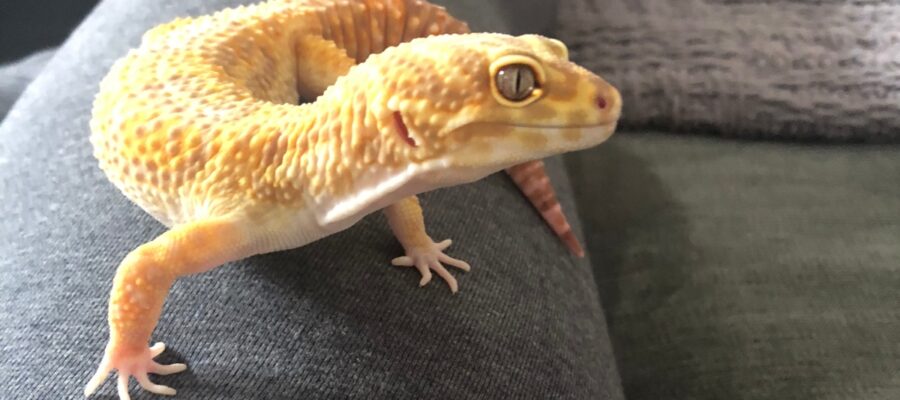On Instagram one of the things I get asked most is “what are your top tips for looking after leopard geckos?” which is a very general question, so I thought it was time to do a post on it.
Aside from the obvious things like making sure you have the correct housing and set up, and food for your leopard geckos, here are some of my favourite tips and hacks that I’ve picked up over the course of being a leopard gecko owner.
Water on cool side, food on warm side
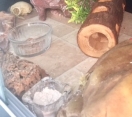 You should always have a warm side and a cool side of your vivarium, and when arranging items in the enclosure, it’s a good idea to keep the water on the cool side and the food on the warm side. This is because the water won’t evaporate as quickly on the cool side, and by keeping the food on the warm side means the insects have more energy and move around more when they’re warm, meaning the geckos will show more interest in them.
You should always have a warm side and a cool side of your vivarium, and when arranging items in the enclosure, it’s a good idea to keep the water on the cool side and the food on the warm side. This is because the water won’t evaporate as quickly on the cool side, and by keeping the food on the warm side means the insects have more energy and move around more when they’re warm, meaning the geckos will show more interest in them.
Kitchen towel in the area they poop
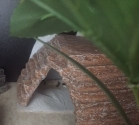 I did a full post on The lazy way to spot-clean your leopard gecko’s vivarium which also includes step-by-step pictures, but to quickly summarise: if you put paper towel down where the leopard geckos poop, it’s much easier to spot clean their vivarium and remove odorous excrement, as you just need to change the dirty kitchen towel for a clean one each time they use it. It takes less than 2 minutes to do and really takes the hassle out of doing the daily gecko maintenance!
I did a full post on The lazy way to spot-clean your leopard gecko’s vivarium which also includes step-by-step pictures, but to quickly summarise: if you put paper towel down where the leopard geckos poop, it’s much easier to spot clean their vivarium and remove odorous excrement, as you just need to change the dirty kitchen towel for a clean one each time they use it. It takes less than 2 minutes to do and really takes the hassle out of doing the daily gecko maintenance!
Buy them a tent for when you want to handle them
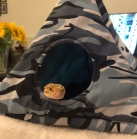 I bought a tent for my geckos from Custom Reptile Homes, which I also reviewed in this post. I rate them so highly, as it makes life a lot less stressful for the geckos AND for me when they’re out of their vivariums. It gives them somewhere to feel safe, they are happy to be handled for much longer, and for me it’s more comfortable than putting a solid hide on my lap every time you want to bring them out. The only downside is getting them to leave the tent when you want to put them back!
I bought a tent for my geckos from Custom Reptile Homes, which I also reviewed in this post. I rate them so highly, as it makes life a lot less stressful for the geckos AND for me when they’re out of their vivariums. It gives them somewhere to feel safe, they are happy to be handled for much longer, and for me it’s more comfortable than putting a solid hide on my lap every time you want to bring them out. The only downside is getting them to leave the tent when you want to put them back!
Use ramekins for food dishes
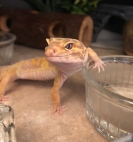 I use clear glass ramekins for my leopard geckos’ food dishes, and they have multiple benefits. They’re quite tall and smooth sided, so most insects (mealworms, morio worms, phoenix worms, dubia roaches, waxworms) can’t escape. They’re clear, so my geckos can easily spot that there are some wiggly insects inside. They’re easy to clean and can be put in the dishwasher, and finally, they’re cheap, I got 4 for £10 from Amazon, but you can find these in loads of home ware shops.
I use clear glass ramekins for my leopard geckos’ food dishes, and they have multiple benefits. They’re quite tall and smooth sided, so most insects (mealworms, morio worms, phoenix worms, dubia roaches, waxworms) can’t escape. They’re clear, so my geckos can easily spot that there are some wiggly insects inside. They’re easy to clean and can be put in the dishwasher, and finally, they’re cheap, I got 4 for £10 from Amazon, but you can find these in loads of home ware shops.
Spray insects with water before dusting with calcium
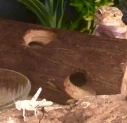 For example, when we are feeding locusts, we will put them in a clear freezer bag, spray inside with water, add calcium and then shake. The calcium sticks really well to the locusts even when they are hopping around trying not to be eaten, and the geckos get a great dose of calcium once they’ve finally caught them. Plus, if any locusts go un-eaten, it’s an awful lot easier for me to spot them when they’re bright white!
For example, when we are feeding locusts, we will put them in a clear freezer bag, spray inside with water, add calcium and then shake. The calcium sticks really well to the locusts even when they are hopping around trying not to be eaten, and the geckos get a great dose of calcium once they’ve finally caught them. Plus, if any locusts go un-eaten, it’s an awful lot easier for me to spot them when they’re bright white!
Spy on your leopard geckos with a Wifi Cam
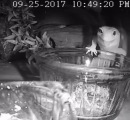 Again, this is outlined in more detail in my post How to spy on your leopard gecko but a great tip from me would be to buy a Wifi Cam to check up on your geckos and see what they’re up to, make sure they’re eating, and check on them when you’re staying away. Added bonus is you get some pretty great photos, perfect for sharing on Instagram! You access a live stream from an app on your phone, and it will also send you screen shots when there’s movement in your vivarium.
Again, this is outlined in more detail in my post How to spy on your leopard gecko but a great tip from me would be to buy a Wifi Cam to check up on your geckos and see what they’re up to, make sure they’re eating, and check on them when you’re staying away. Added bonus is you get some pretty great photos, perfect for sharing on Instagram! You access a live stream from an app on your phone, and it will also send you screen shots when there’s movement in your vivarium.
Keep insects in the fridge
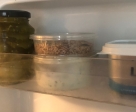
I like to keep some insects in the fridge for various reasons. For locusts, this slows them down, so they are less likely to jump and escape when I’m about to feed them to the geckos. For other insects, it again slows their bodily functions down, which can mean they live longer in their current form. For example, I can keep wax worms in my fridge door for months (not the main bit of the fridge as this is too cold), to make sure they don’t turn into moths.
We are now selling vinyl substrate: click here to purchase some


